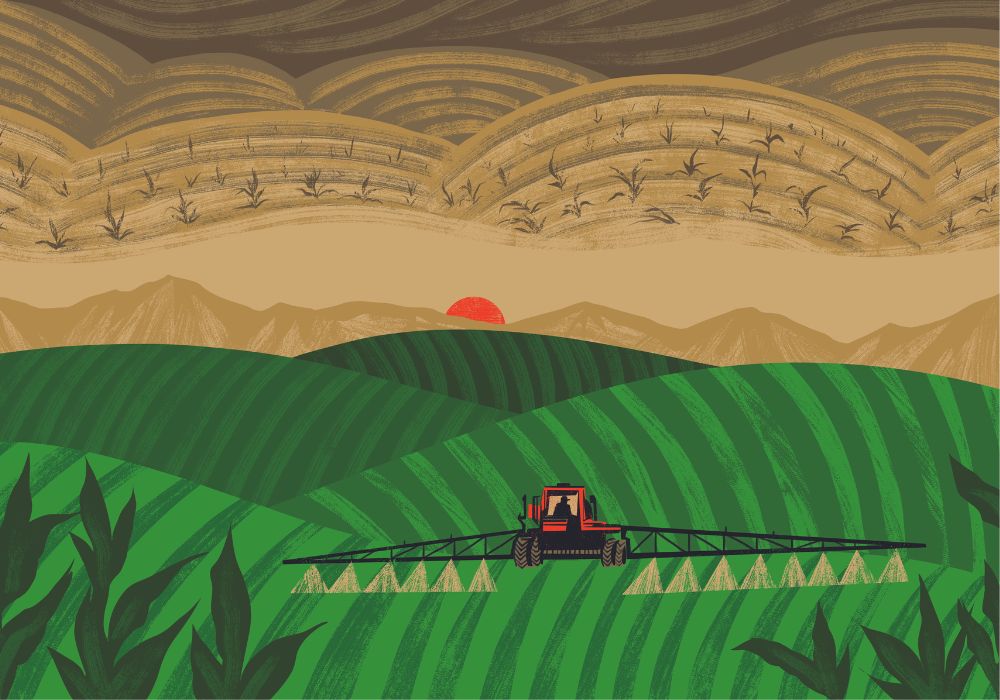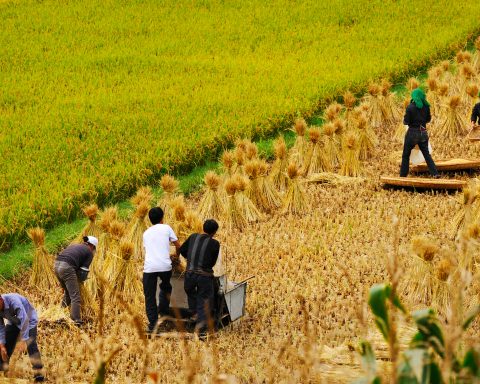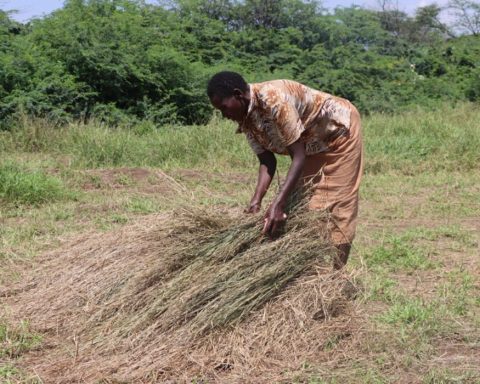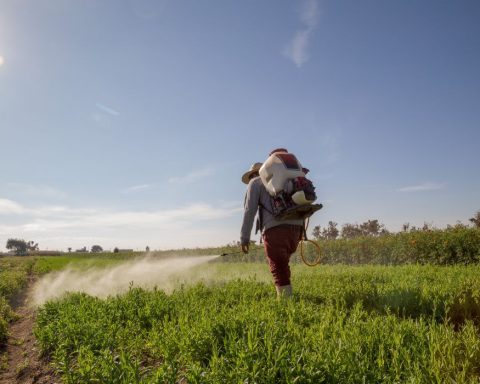When he was a young boy growing up on a farm in southern Israel, Assaf Dotan says, there were always lots of wild animals around. But over the years, he noticed their numbers dwindled as the farmers in the area started using more chemical products in their fields. One of those products was synthetic nitrogen fertilizer.
Dotan is now the CEO of Grace Breeding, an Israeli agricultural tech start-up that has developed what it says is a biological alternative to synthetic fertilizers, which emit nitrous oxide, a potent greenhouse gas, when applied in fields. Dotan’s company is one of dozens around the globe looking to offer a biological substitute to chemical fertilizers. “For many years, agriculture has grown by using chemical products,” he says. “From their production process through to application in the field, [they] are causing harm to the climate.”
As one of the main nutrients needed to grow food, along with potash and phosphorus, nitrogen has been used by farmers to fertilize their crops for millennia. The compound is naturally present in a variety of sources, from composted plants and legumes to manure and seabird poop (which was shipped around the world from Peru in the 19th century). The invention of synthetic nitrogen fertilizers, however, in the early 20th century, changed everything.
Before synthetic nitrogen was made for widespread use by farmers, governments used it to build explosives during the Second World War. After the war, the same factories that were synthesizing nitrogen for munitions shifted to manufacturing fertilizer. Since then, governments have pushed farmers to double and redouble yields (and use more fertilizer as a result) by raising food export quotas to feed the world’s growing population. Those yields have come with severe environmental impacts, as research shows that the nitrogen fertilizer supply chain accounted for more than 10% of agricultural emissions in 2018. But it doesn’t need to.
A handful of governments around the world have acknowledged that synthetic nitrogen fertilizers are a significant part of solving the problem. After all, agriculture accounts for about a quarter of the world’s greenhouse gas emissions. The European Union is aiming to reduce fertilizer use by 20% by 2030. Last year, the Dutch government set a target to reduce nitrogen emissions by 50% by 2030. In the U.S., the Biden administration has not set an emission-reduction target for fertilizer, but it has launched a $500-million program that will give grants to domestic fertilizer production it defines as “innovative” and “sustainable.”
In Canada, the federal government set a target to lower fertilizer emissions by 30% from 2020 levels by 2030, which has kicked up some controversy. Some Canadian farmers and agricultural organizations have pushed back against the target, erroneously claiming that the government is going to control the amount of fertilizer they use. Others have said it would lead to famine. The provincial governments of Saskatchewan and Alberta chimed in last summer to express “profound disappointment” in the federal government’s target, calling it “arbitrary” and an attack on farmers. But experts have said that the target can be achieved without threatening the food supply and that the solutions to reach it would actually save farmers money.
We are thus fertilizing not just fields but, indirectly, also many natural ecosystems – and interfering in nitrogen’s flows to a much higher extent than in the case of other biospheric cycles.
– Vaclav Smil, author of Enriching the Earth
To help farmers achieve the 30% voluntary goal, the government is funding programs that train farmers to use better nitrogen management and cover crops. One 2012 study found that farmers can use less synthetic nitrogen fertilizer by simply rotating three or four crops on a field rather than just two while producing the same amount of food. There are also other potential solutions that can bring down emissions without sacrificing yields, such as those Grace Breeding and others have developed. A large part of the battle is getting farmers on board.
Feeding our fertilizer habit
It wasn’t until the 19th century that chemists understood nitrogen cycles and the nutrient’s role in plant growth. In 1909, Fritz Haber, a German chemist working under contract for agrochemical company BASF, first synthesized the fertilizer ammonia from atmospheric nitrogen. Synthetic fertilizers really began to take off after the Second World War. Worldwide capacity more than doubled in the 1960s as part of the Green Revolution. And by 1985, the world was making more than 70 million tonnes per year. Today the chemical fertilizer market is forecast to be worth US$169.17 billion in 2023, according to the Chemical Fertilizers Global Market report – a figure that keeps climbing skyward.
In Canada, fertilizer use increased by a staggering 71% between 2005 and 2019, mostly driven by fertilizer sales in Western Canada, according to the federal government, while emissions from fertilizer application grew by 54%. In 2019, nitrogen fertilizers in Canada caused 12.75 million tonnes of greenhouse gas emissions – the equivalent of 3.9 million cars. Over the years, synthetic fertilizers have helped boost yields to feed the world’s growing population. Nitrogen expert Vaclav Smil, author of Enriching the Earth, credits the synthesizing of ammonia with keeping world hunger in check. “Without this synthesis about 2/5 of the world’s population would not be around – and the dependence will only increase,” he wrote.
But making and applying all that synthetic fertilizer is unsustainable. The production of synthetic fertilizers alone, before farmers even sprinkle the stuff on their fields, requires copious quantities of natural gas (much of which comes from fracking, at least in the U.S.) and has significant CO2 emissions. And in addition to the nitrous oxide emissions from application, excess synthetic nitrogen fertilizer can also run off into streams and other waterways, harming water ecosystems and causing massive toxic algal blooms.
“We are thus fertilizing not just fields but, indirectly, also many natural ecosystems – and interfering in nitrogen’s flows to a much higher extent than in the case of other biospheric cycles,” Smil wrote.
Solutions cropping up
Jordan Wallace knows that when he sees dandelions sprout, the soil is warm enough to start planting his crop for the season. When he sees buds on trees and lilacs blossom, he knows that there’s finally enough sunlight and little chance of frost returning. But for what the natural world doesn’t tell him, there’s data.
As the farmer-in-residence at a research hub for tech start-ups called Area X.O, Wallace is conducting research with University of Ottawa professors on the effectiveness of a fertilizer system called innovative fertile striptilling. The method, which Wallace’s father, Morley, developed, involves placing fertilizer only where the crop needs it and tilling narrow strips of land. The data from Wallace’s first two years of research have been promising: the method requires 33% less fertilizer than conventional farming practices, increases yield and profit by around 30% and decreases nitrous oxide emissions by more than 90%.
However, he says, there are still skeptics in the farming community. “Most farmers won’t look at something unless there’s a three-year study completed on it,” he says. “They want to see some research, and they want to try it on their own farm.”
The Wallaces, who own a precision agriculture firm called GPS Ontario and farm 150 acres just south of Ottawa, have been working on this system for almost a decade. But it wasn’t until Wallace started working at the Ottawa Smart Farm at Area X.O that he was able to show just how much it was cutting emissions. The organization provided sensors that measure how much nitrous oxide is coming off the crops Wallace is growing using the technique.
The government has to understand it can’t keep doubling and redoubling the output from the system if it wants to meet its emissions reduction targets.
– Darrin Qualman, Canada’s National Farmers Union
And the method has been productive.
“We couldn’t get above 165 bushels per acre in corn. It didn’t matter what we did. And my home farm averaged 264 bushels last year,” says Wallace.
He says the method has been slow to take off so far, largely because of the skepticism of farmers. There is also a learning curve and an initial cost to buy the necessary machinery – $75,000 to $500,000, depending on the size of the farm. But Wallace says the system can replace multiple machines. And ultimately, farmers will be spending less money on fertilizer.
No new technology needed
While there are a growing number of tech solutions coming on the market, experts say the technologies needed to bring down fertilizer emissions already exist. Sustainable farming advocates say Canadian agriculture can meet the government’s 30% target using better fertilizer management and other solutions like the enhanced-efficiency fertilizer that’s available.
“You can imagine it like if you drive your car a little differently – if you don’t accelerate as fast or drive a little slower, the fuel economy goes up. It’s the same thing with fertilizer,” says Darrin Qualman, the director of climate crisis policy and action at Canada’s National Farmers Union. “If you run the system a little differently, the emissions from fertilizer go down.”
Qualman says that “a lack of coherence” in the federal government’s policies when it comes to food exports is hampering Canadian farmers’ ability to achieve meaningful emission reductions. On the one hand, the government has a target to reduce emissions from fertilizer. And on the other hand, it has a target that increases food exports.
“The government has to understand it can’t keep doubling and redoubling the output from the system if it wants to meet its emissions reduction targets,” he says. “You can switch to a [Toyota] Prius, but if you drive twice as much, your fuel use goes up, not down.”
Back in Israel, Dotan says Grace Breeding is planning to have what it calls its bio-fertilizer on the market in Brazil, the largest importer of fertilizer in the world, by mid-2024. Researchers at the University of Londrina in Brazil tested one of Grace Breeding’s products and found that it outperformed urea, a synthetic nitrogen fertilizer, when applied to corn and resulted in fewer emissions.
The company, which completed an initial public offering last year on the Tel Aviv Stock Exchange, claims its product can reduce synthetic fertilizer use by up to 50%. While Grace Breeding wants to ultimately help farmers use less chemical fertilizer, Dotan says he sees a future in which there is a balance of biological and chemical products being used. “I don’t know what will happen in the future,” he says. “Relying 100% on chemicals isn’t the way, but relying 100% on biological products would be very hard. Farming will need to find an equilibrium point.”
Alex Robinson is an Ottawa-based journalist and deputy editor at Corporate Knights







